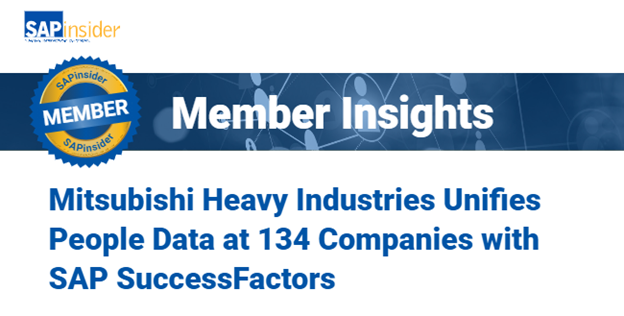Mastering SAP Series – Human Resources & Payroll
Meet the Authors
SAPInsider’s Mastering SAP series is built on a foundation of significant research undertaken with customers, partners, independent thought leaders and SAP employees both home and abroad. Each year we engage with key individuals around the world to understand their existing challenges, their pain points and the opportunities that they see to get the most out of their SAP suite of tools in their line of business. In addition to numerous one-on-one interviews, this year we connected with a myriad of cross-industry SAP customers through a series of virtual round table discussion groups. The following report represents the community snapshot and findings across the HR and Payroll research body of work.
PARTICIPANT PROFILE
The discussion groups brought together HR and Payroll professionals, and IT teams who leverage SAP’s technology stack of tools from a wide variety of industry sectors including mining, financial services, education, public sector, healthcare, energy, industrial machinery, food & beverage, transport, defence.
Some of the job titles of participants include:
Solution Architect – HR Manager – HCM Applications Senior Director HR Technology HR Manager Process and Systems Payroll Systems Manager Director IT Products – HR & Payroll
Explore related questions
The COVID-19 pandemic has accelerated the notion of organisation’s “being digital”. By coincidence the pandemic has acted as a gauge for organisations to understand how digitally mature they really are and highlighted the fact that “being digital” is not just about technology, but the human interactions with technology.
HR and Payroll is no longer viewed as a purely administrative function tasked with only managing employee information and ensuring people are paid on time. Smart organisations see the strategic value and influence that can come from HR and Payroll leaders in today’s post- COVID world. Finding, engaging, winning and retaining talent is crucial to keeping a business strong in a fiercely competitive recruitment market. Hybrid and remote working are here to stay. The way organisation’s engage and collaborate with their workforce won’t look the same as it did pre-COVID.
Companies want diversity of gender, race, thought, capability and age and to foster inclusivity and belonging, to draw out the best in their people. Employees now have higher expectations and want access to digital experiences that recognises them as humans – their unique values, skills and motivations. With all of this in mind, how do organisation’s leverage their SAP platforms to deliver on these expectations?
The following seven topics were identified during our research with the community for Mastering SAP HR & Payroll 2022:
- Employee Experience Management (HXM)
- The Employee Lifecycle
- Learning, Development & Talent Management
- Performance Management
- HR Analytics – Data, Reporting & Dashboarding
- Core Payroll & Single
- The SAP Roadmap
1) EMPLOYEE EXPERIENCE MANAGEMENT (HXM)
Experience is the new employment currency when it comes to workplace productivity and retention. The employee’s journey and experience has become even more architected and guarded by company leadership and HR practitioners, as they navigate the needs of a post-COVID workforce.
SAP SuccessFactors are making a big play in this space and have brought several new and exciting solutions to market to play alongside their initial Qualtrics acquisition (2018). The Capability Portfolio (CapPort), SAP SuccessFactors Opportunity Marketplace (OMP) and SAP Work Zone are all hot news and bolster SAP’s HXM offering. The Mastering SAP community expressed interest in learning more about these tools and understanding how they can elevate their employee’s experience to solve the challenges they are facing. Qualtrics, which engages with employees via surveys that analyse sentiment is understood by the community as more customers have taken this up.
The big picture for “Employee Experience” sits around how employees manage their careers and employers wanting to be more tuned into their employees needs and aspirations. But drilling down into what it means for the Mastering SAP community and the conversation becomes more granular – leaning towards interest in how users interact with their SAP SuccessFactors instances, rather than changing ways of working.
Questions we heard raised:
- How does your organisation define Employee Experience?
- How do you understand UX needs by generation, industry, and business process?
- How do you get non-office-based workforce onto your SF systems? What is the cost of an SAP SuccessFactors Opportunity Marketplace subscription?
- What are the benefits of SAP’s Work Zone collaboration tool versus Microsoft Teams?
- How do you measure UX’s role in talent and retention?
- What are the user implications for the migration to the new SuccessFactors home page?
- Who should own the data collected from Qualtrics surveys? Department lead or the HR function?
- Can you create role-based dashboards for managers and leaders to have a view on employee experiences?
- How do you create a business case for Qualtrics for customers using free survey tools?
- Can survey results be embedded into SAP Analytics Cloud for company-wide performance analytics?
2. THE EMPLOYEE LIFECYCLE – RECRUITING, ONBOARDING, CROSS BOARDING & OFF- BOARDING
The recruitment landscape is the most fragmented and challenging it has been for some time. A War on Talent, the Great Attrition or Great Resignation are all terms being discussed by HR practitioners and thought leaders around the world, as organisations get to grips with the new wants and needs of a post-pandemic workforce.
Robust recruitment practices have always been viewed as a competitive advantage, but in some cases the rules of engagement have changed. The supply and demand scale has tipped and so organisations need to leverage technology and processes to streamline their recruitment and onboarding, more than ever. Those at the forefront in the community are already trialling and implementing AI technology such as “Hiring-BOTS”.
There is a view that SAP SuccessFactors Recruitment has been slow to implement new functionality in the last few years. Many customers are moving to using external recruitment tooling, while keeping SAP SuccessFactors Recruitment to give them deeper integration into Employee Central and onboarding. SuccessFactors offers an online portal for recruitment that sync’s to LinkedIn and other job portals, but the customers we spoke with felt it didn’t yet elicit the right engagement from candidates.
The recruitment and onboarding processes can be inconsistent across departments, due to the hiring process typically being run by a department line manager. We heard that the community felt that SAP Onboarding is one of the more challenging offerings in the SuccessFactors suite. HR leaders noted it required a lot of effort and persistence to get their business managers to embrace SAP Onboarding, but once they get there – the benefits are worth it. A welcome improvement due soon from SAP for onboarding is the integration of Tax and Superannuation forms from onboarding into Employee Central.
SAP’s Centre of Capabilities move into SAP SuccessFactors is an exciting opportunity for cross-boarding, offering employees the chance to consider what their next internal career move might be. This is also of interest for organisations that work on a project-based structure, as adverts can be placed for roles across the organisation and gives employees a reason to manage and track their own capabilities.
Customers asked the following questions relating to Recruitment and Onboarding:
- How can BOTS, AI and RPA assist with onboarding and low value tasks such as resume screening?
- If you’re an SAP Onboarding 1.0 customer, when should you move to SAP Onboarding 2.0?
- What will onboarding look like with more people working from home?
- What are SAP’s latest offerings to help with the post-COVID recruitment and onboarding landscape?
- What new recruitment approaches should organisations take in today’s market?
- Do SAP offer a tool to help reach talent moving around in the job market?
- What are the most valuable features/functions in an Onboarding system?
- What do I need to get right to optimise the SAP Center of Capabilities for cross-boarding?
- How do you leverage SAP SuccessFactors Recruitment tool in a way that marries the true requirements of the role to suitable candidates?
- How do you create an engaging recruitment process that attracts candidates and retains a candidate’s interest throughout the hiring process?
- How do you integrate your onboarding process with various parts of the business to ensure their time to productivity is reduced?
- What are the best practices for leveraging SAP SuccessFactors recruitment portal for online job posting?
- Can you integrate the onboarding process to collect all employee information for onboarding and payroll across multiple tools?
- How can SuccessFactors assist with recruitment and onboarding compliance requirements?
3. LEARNING, DEVELOPMENT & TALENT MANAGEMENT
In the last twelve months, there has been a huge amount of momentum in the learning space.
The community is embracing technology to identify groups of employees in their business that need training and are using AI tools to suggest how the training can be fulfilled. SAP products in this space include Litmos and SuccessFactors Learning, some customers are trying to understand the pros and cons of each for their specific business scenario. Organisations are finding smarter ways of matching skills gaps to tools that will help close the skill gap. There is also a trend in LinkedIn learning tools being adopted by organisations.
The big news in this space from SAP was the acquisition of SwoopTalent by SAP SuccessFactors in August 2021, now brought into the SAP SuccessFactors portfolio under the name SAP SuccessFactors Opportunity Marketplace (OMP) offering a consolidated view of career paths, skills, competencies, and availability. It is essentially an AI driven automatic data management platform, that interrogates, interprets and automatically connects disparate talent datasets inside and outside the enterprise. It manages structured, semi-structured and unstructured data from all sources. Put differently, SAP OMP provides individuals the chance to find and pursue internal opportunities that align with their personal values, passions and interests as well as the strategic needs of the business.
The relationship between OMP and Capability Portfolio (CapPort) is worth mentioning. OMP is perhaps going to be as useful to customers as it doesn’t come with an additional subscription, but to best utilise it, SAP customers will need to build out CapPort for their business, first.
4. PERFORMANCE MANAGEMENT
Measuring the performance of your workforce, particularly when outcomes are vague and hard to identify is a challenge for the SAP customers we spoke with. Remuneration and employee recognition are all motivators, but how do you use SAP to assess the status of employee satisfaction, and present it accurately to leadership? Some of the questions customers would like answers to are:
- How do you use SAP SuccessFactors Performance & Goals tool in a way that delivers value to the bottom line when the people factors are often hard to measure?
- What are the best practices to creating performance measurements that are aligned to corporate strategy?
- How do you provide constant feedback to employees that delivers a positive coaching experience compared to a micro-management experience?
- What are some gamification methods for competition of performance – particularly for sales staff?
- What role can Qualtrics play in measuring job satisfaction?
- How to you manage poor performance and monitor its progression? What are ways to get senior buy-in for performance management tools and being able to treat it as an ongoing function, not a once- a-year review?
- How vital is a performance management framework? What are the costs of not developing one?
- How are others managing their Employee Documents in SAP?
- What are customer’s experience with SAP Time Tracker?
5. HR ANALYTICS – DATA, REPORTING & DASHBOARDING
To attract the best staff and remain relevant, post-pandemic organisations have a greater responsibility to take a more altruistic view of their workforce. That the pervasive thinking of our time pertaining to the workforce goes beyond measuring performance, staff turnover, workforce availability and time in attendance. We must understand sentiment and pay attention to likelihood of retention, mental health and wellbeing, diversity and inclusion, employee engagement, and job satisfaction. HR Analytics needs to reflect this. It must work harder to be real-time, pull from broader sources, and quickly paint a rich view of the workforce that can drive business insights and decision making.
SAP SuccessFactors (SAPSF) offers SAP Analytics Cloud (SAC) as part of its SAP People Analytics solution through one license. This means customers can leverage some SAC functionality within People Analytics specifically on their SAPSF data. SAP has been focused on more user-friendly output and dashboards in the form of SAP SuccessFactors Stories in People Analytics (SiPA). This is available to all customers, supplementary to existing SAP SuccessFactors reporting functionality. This is a more sophisticated dashboard style of reporting for learning and leave released in mid-2021 and is an area the community the community would like to know learn more.
While some are embracing SAC, some customers shared that they see better returns from using Power BI and third-party tools such as SpinifexIT to combine their data from several sources.
We heard the following from customers:
- How do you define your HR reporting strategy?
- How mature is SAP’s People Analytics solution?
- How does SAP’s People Analytics solutions compare to third party/self-service tools available in the market?
- Can you create unified data modelling across on-premise and cloud solutions for better reporting?
- Is there a native integration from SAP SuccessFactors into the People Analytics Solution? And if not, the what development is required?
- How does SAP People Analytics configure into the Core SAP HCM solution for customers not currently using SAP SuccessFactors?
- How does People Analytics’ Workforce planning differ from the current Workforce Planning Solution?
- How do you work with your tech team to create a self-service culture for HR reporting?
- How do you get your people data to work for you via analytics and dashboarding?
- Can you create “trigger” events to alert people who need to action certain data cases, and then link them to dashboards to do the analysis and action?
- How do you protect your people data, by restricting who can access it row level access?
6. CORE PAYROLL & SINGLE TOUCH PAYROLL
Payroll is a function that companies cannot afford to get wrong. In recent times Payroll has had to absorb many regulatory changes and has endured much focus particularly around underpayment in Australia. Payroll can often be the last HR solution to be implemented, after all if it’s working ok, why change it? Payroll departments can be time poor, but rushed implementations, result in more manual processing work for a team further down the line.
In the 2019–20 Budget, the Government announced that Single Touch Payroll (STP) would be expanded to be known as STP Phase 2. The aim is to reduce reporting burden for employers who need to report information about their employees to multiple government agencies. The anticipated mandatory start date for Phase 2 reporting is 1 January 2022, although SAP has an exemption/delayed timeline for STP Phase 2 the community are planning for this and want to ensure their solutions are agile and they have their data ready to comply with the ATO.
Some organisations have shifted towards a model that is more reliant on SAP for their Payroll activities, having opted to remove business analysts from the process. They need to understand how to utilise SAP
Payroll better as their inhouse traditional payroll capability declines.
The community wants to know what SAP are doing to help them in all of these areas. The cost of getting Payroll wrong can be significant and the risk is often deemed greater than the reward of implementing or upgrading new tools. The questions we heard:
- How do you ensure you can get the right qualified resources for your implementation?
- How to avoid project scope creep and secure enough time for your implementation?
- How do manage the huge amount of regression testing required? What new functionality exists in managing Employee’s profiles across SAP?
- What risk mitigating precautions can be taken when updating the Payroll System?
7. THE SAP ROAD MAP
Customers expressed the need for SAP to set and commit to a long- term vision and roadmap that their businesses can align to. Irrespective of delays of these solutions becoming available, understanding exactly where SAP are headed will provide clarity and give an opportunity for HR to prepare.
- What will be in core SAP Employee Central going forward?
- What will the relationship be between SAP and Kronos?
- What will the reimagine home page for SuccessFactors mean with forced migration in 1H2022?
- Pros and cons of SAP Core Payroll vs Employee Central Payroll? What does SuccessFactors have planned for scheduling? We’re not haring much here How do we sell the road map in the organisation?
- How do you overcome the language barrier between the techie and HR practitioners?
- How do you find the right business process owner, that can be over the detail, understand the business process needs and functionality?
- How do understand what is possible in the design of a solution? What do we need to deliver for the future?
- How are others implementing Onboarding via modules to innovate in bite sized pieces?
- How do you sweat your SAP HR assets to get the value you need? What’s coming from SAP to help with legislation around vaccine and booster tracking?
- What are others doing in this area and what level of information is required?








